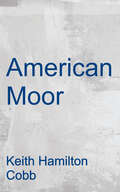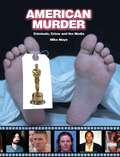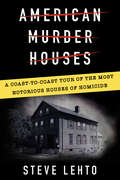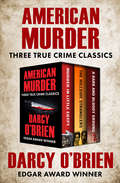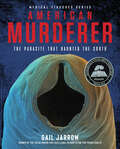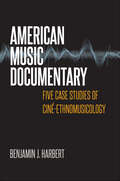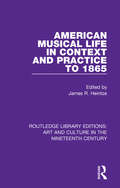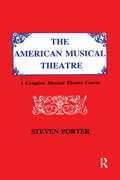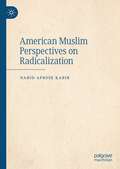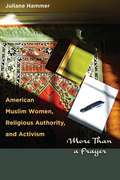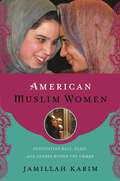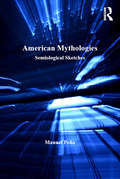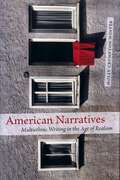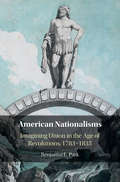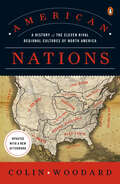- Table View
- List View
American Moor (Modern Plays Series)
by Keith Hamilton CobbKeith Hamilton Cobb embarks on a poetic exploration that examines the experience and perspective of black men in America through the metaphor of Shakespeare's character Othello, offering up a host of insights that are by turns introspective and indicting, difficult and deeply moving. American Moor is a play about race in America, but it is also a play about who gets to make art, who gets to play Shakespeare, about whose lives and perspectives matter, about actors and acting, and about the nature of unadulterated love.
American Mourning: Tragedy, Democracy, Resilience
by Simon StowHow does the way in which a democratic polity mourn its losses shape its political outcomes? How might it shape those outcomes? American Mourning: Tragedy, Democracy, Resilience answers these questions with a critical study of American public mourning. Employing mourning as a lens through which to view the shortcomings of American democracy, it offers an argument for a tragic, complex, and critical mode of mourning that it contrasts with the nationalist, romantic, and nostalgic responses to loss that currently dominate and damage the polity. Offering new readings of key texts in Ancient political thought and American political history, it engages debates central to contemporary democratic theory concerned with agonism, acknowledgment, hope, humanism, patriotism, and political resilience. The book outlines new ways of thinking about and responding to terrorism, racial conflict, and the problems of democratic military return.
American Multicultural Studies: Diversity of Race, Ethnicity, Gender and Sexuality
by Sherrow O. PinderAmerican Multicultural Studies: Diversity of Race, Ethnicity, Gender and Sexuality provides an interdisciplinary view of multicultural studies in the United States, addressing a wide range of topics that continue to define and shape this area of study. Through this collection of essays Sherrow Pinder responds to the need to open up a rich avenue for addressing current and continuing issues of race, gender, ethnicity, sexuality, cultural diversity, and education in their varied forms. Substantial thematic overlaps are found between sections and essays, all of which are oriented toward a single broad objective: to develop new and different ways of addressing how multicultural issues, in their discursive sociocultural contexts, are inextricably linked to the operations of power. Power, as a site of resistance to which it invariably gives rise, is tacked from a perspective that attends to the complexities of America's history and politics.
American Murder
by Mike MayoInvestigating the way Hollywood scoops up notorious criminals and turns them into legends, this entertaining who's-who guide provides thumbnail sketches of such killers as Ma Barker, Black Beard, Al Capone, John Wesley Hardin, and Charles Starkweather. Noting that some figures are glamorized in popular culture (Jesse James), while others are demonized (Charles Manson), this encyclopedic collection explores the legends' emotional truths as depicted in movies, stories, and songs. Facts of the real cases behind these notorious criminals are also presented, including the landmark rulings that pioneered new approaches to criminal justice.
American Murder Houses
by Steve LehtoThere are places in the United States of America where violent acts of bloodshed have occurred.Years may pass--even centuries--but the mark of death remains.They are known as Murder Houses. From a colonial manse in New England to a small-town home in Iowa to a Beverly Hills mansion, these residences have taken on a life of their own, gaining everything from local lore and gossip to national--and even global--infamy.Writer Steve Lehto recounts the stories behind the houses where Lizzie Borden supposedly gave her stepmother "forty whacks," where the real Amityville Horror was first unleashed by gunfire, and where the demented acts of the Manson Family horrified a nation--as well some lesser-known sites of murder that were no less ghastly.Exploring the past and present of more than twenty-five renowned homicide scenes, American Murder Houses is a tour through the real estate of some of the most grisly and fascinating crimes in American history.INCLUDES PHOTOGRAPHS
American Murder: Three True Crime Classics
by Darcy O'BrienThree riveting accounts of horrific crimes and the twisted minds behind them by an Edgar Award–winning author, in one volume. A father&’s ultimate betrayal, a savage killing spree that terrorized Los Angeles, and the brutal slaying of a rich man&’s college-aged daughter. In this heart-stopping true crime collection, New York Times–bestselling author Darcy O&’Brien uncovers the dark underside of the American dream. Murder in Little Egypt: Dr. John Dale Cavaness selflessly attended to the needs of his small, southern Illinois community. But when Cavaness was charged with the murder of his son Sean in December 1984, a radically different portrait of the physician and surgeon emerged. Throughout the three decades he had basked in the admiration and respect of the people of Little Egypt, Cavaness was privately terrorizing his family, abusing his employees, and making disastrous financial investments. In this New York Times bestseller, as more and more grisly details come to light, so too does rural America&’s heritage of blood and violence become clear. The Hillside Stranglers: For weeks, the body count of sexually violated, brutally murdered young women escalated. With increasing alarm, Los Angeles newspapers headlined the deeds of a serial killer they named the Hillside Strangler. But not until January 1979, more than a year later, would the mysterious disappearance of two university students near Seattle lead police to the arrest of a security guard—the handsome, charming, fast-talking Kenny Bianchi—and the discovery that the strangler was not one man but two. The Hillside Stranglers is the disturbing portrait of a city held hostage by fear and a pair of psychopaths whose lust was as insatiable as their hate. A Dark and Bloody Ground: On a sweltering evening in August 1985, three men breached Roscoe Acker&’s alarm and security systems, stabbed his daughter to death, and made off with over $1.9 million in cash. The killers were part of a hillbilly gang led by Sherry Sheets Hodge, a former prison guard, and her husband, lifetime criminal Benny Hodge. The stolen money came in handy shortly afterward, when they used it to lure Kentucky&’s most flamboyant lawyer, Lester Burns, into representing them. &“The smell of wet, coal-laden earth, white lightning, and cocaine-driven sweat rises from these marvelously atmospheric—and compelling—pages&” (Kirkus Reviews).
American Murderer: The Parasite that Haunted the South (Medical Fiascoes)
by Gail JarrowWhat made workers in the American South so tired and feeble during the 19th and early 20th centuries? This exciting medical mystery uncovers the secrets of the parasite hookworm, commonly known as the &“American Murderer,&” and is the latest title in Gail Jarrow&’s (YALSA Excellence in Nonfiction for Young Adults award-winning author) Medical Fiascoes series.Imagine microscopic worms living in the soil. They enter your body through your bare feet, travel to your intestines, and stay there for years sucking your blood like vampires. You feel exhausted. You get sick easily. It sounds like a nightmare, but that&’s what happened in the American South during the 1800s and early 1900s. Doctors never guessed that hookworms were making patients ill, but zoologist Charles Stiles knew better. Working with one of the first public health organizations, he and his colleagues treated the sick and showed Southerners how to protect themselves by wearing shoes and using outhouses so that the worms didn&’t spread. Although hookworm was eventually controlled in the US, the parasite remains a serious health problem throughout the world. The topic of this STEM book remains relevant and will fascinate readers interested in medicine, science, history—and gross stories about bloodsucking creatures.
American Music Documentary: Five Case Studies of Ciné-Ethnomusicology
by Benjamin J. HarbertDocumentary filmmakers have been making films about music for a half-century. American Music Documentary looks at five key films to begin to imagine how we might produce, edit, and watch films from an ethnomusicological point of view. Reconsidering Albert and David Maysles's Gimme Shelter, Jill Godmilow's Antonia: A Portrait of the Woman, Shirley Clarke's Ornette: Made in America, D.A. Pennebaker's and Chris Hegedus's Depeche Mode: 101, and Jem Cohen's and Fugazi's Instrument, Harbert lays the foundations for the study and practice of "ciné-ethnomusicology." Interviews with directors and rich analysis from the disciplinary perspectives of film studies and ethnomusicology make this book a critical companion to some of the most celebrated music documentaries of the twentieth century.Hardcover is un-jacketed.
American Music Librarianship: A Research and Information Guide
by Carol June BradleyThe literature of American music librarianship has been around since the 19th century when public libraries began to keep records of player-piano concerts, significant donations of books and music, and suggestions for housing music. As the 20th century began, American periodicals printed more and more articles on increasingly specialized topics within music studies. Eventually books were developed to aid the music librarian; their publication has continued over the course of nearly a century. This book reflects the great diversity of the literature of music librarianship. The main resources included are items of historical interest, descriptions of individual collections, catalogues of collections, articles describing specific library functions, record-related subjects, bibliographies designed for music library use, literature from Canada and Britain when relevant to U.S. library practices, key discographies, and information on specialized music research. The material is ordered by topic and indexed by author, subject, and library name.
American Musical Life in Context and Practice to 1865 (Routledge Library Editions: Art and Culture in the Nineteenth Century #5)
by James R. HeintzeFirst published in 1994. This study covers a wide cross-section of topics, individuals, groups, and musical practices representing various regions and cities. The subjects discussed reflect the religious, ethnic, and social plurality of the American musical experience as well as the impact on cultural society provided by the arrival of new musical immigrants and the internal movements of musicians and musical practices. The essays are arranged principally on the basis of the historical chronology of the cultural practices and subjects discussed. Each article helps to shed additional light on cultural expressions through music in eighteenth- and nineteenth-century America.
American Musical Theatre
by Steven PorterFirst Published in 1987. Split into four parts, this book seeks to inform the reader, teachers, directors and students about American Musical Theatre. Part I is a brief history of the American Musical Theatre, for it is only in the context of history that the material on which you work can be fully judged and mastered. Part II is a brief discussion of the elements of production. Knowing what ought to take place in a well-planned show can go a long way toward counteracting what does not take place in a poorly planned one. Part III is a brief discussion of how to evaluate the elements of craftmanship one expects to find in the writing and performing of a musical. The knowledge here is indispensable to the performer. It is the feel of the plane to the pilot, the touch of the key to the pianist. It is, in fact, the very life blood of the art form. Finally, Part IV provides an opportunity to put into practice what previous study has taught.
American Muslim Perspectives on Radicalization
by Nahid Afrose KabirThis book is a study of American Muslims' perspectives on Muslims who become radicalized and choose to support the Islamic State. Muslim radicalization is a global phenomenon that has affected American Muslims as it has Muslims throughout the world. In 2015, approximately 250 Americans joined the Islamic State (IS), and some still sympathize with it. Based on 51 in-depth interviews conducted in nine states from 2017 to 2021, this book offers a thematic understanding of radicalization, touching on themes such as Islamic history, Muslims' social and political identities, cultural dilemmas, radicalization outlets, mental health, media stereotypes, Islamophobia, security, and the impact of COVID-19 on radicalization. This book differs from previous scholarship on the causes of radicalization by focusing on the perspectives of non-radicalized American Muslims. While some previous scholarship has focused on Muslim radicalization in Europe, this book provides a new spectrum of views from the United States. It also offers pathways to de-radicalization. The interview data is complemented with relevant literature, analysis of media perspectives, and the author's personal observations.
American Muslim Women, Religious Authority, and Activism: More Than a Prayer
by Juliane HammerFollowing the events of September 11, 2001, American Muslims found themselves under unprecedented scrutiny. Muslim communities in the United States suffered from negative representations of their religion, but they also experienced increased interest in aspects of their faith and cultures. They seized the opportunity to shape the intellectual contribution of American Muslims to contemporary Muslim thought as never before. Muslim women in particular-often assumed to be silenced, oppressed members of their own communities-challenged stereotypes through their writing, seeking to express what it means to be a Muslim woman in America and carrying out intra-Muslim debates about gender roles and women's participation in society. Hammer looks at the work of significant female American Muslim writers, scholars, and activists, using their writings as a lens for a larger discussion of Muslim intellectual production in America and beyond. Centered on the controversial women-led Friday prayer in March 2005, Hammer uses this event and its aftermath to address themes of faith, community, and public opinion. Tracing the writings of American Muslim women since 1990, the author covers an extensive list of authors, including Amina Wadud, Leila Ahmed, Asma Barlas, Riffat Hassan, Mohja Kahf, Azizah al-Hibri, Asra Normani, and Asma Gull Hasan. Hammer deftly examines each author's writings, demonstrating that the debates that concern American Muslim women are at the heart of modern Muslim debates worldwide. While gender is the catalyst for Hammer's study, her examination of these women's intellectual output touches on themes central to contemporary Islam: authority, tradition, Islamic law, justice, and authenticity.
American Muslim Women: Negotiating Race, Class, and Gender within the Ummah (Religion, Race, and Ethnicity)
by Jamillah KarimAfrican American Muslims and South Asian Muslim immigrants are two of the largest ethnic Muslim groups in the U.S. Yet there are few sites in which African Americans and South Asian immigrants come together, and South Asians are often held up as a “model minority” against African Americans. However, the American ummah, or American Muslim community, stands as a unique site for interethnic solidarity in a time of increased tensions between native-born Americans and immigrants.This ethnographic study of African American and South Asian immigrant Muslims in Chicago and Atlanta explores how Islamic ideals of racial harmony and equality create hopeful possibilities in an American society that remains challenged by race and class inequalities. The volume focuses on women who, due to gender inequalities, are sometimes more likely to move outside of their ethnic Muslim spaces and interact with other Muslim ethnic groups in search of gender justice.American Muslim Women explores the relationships and sometimes alliances between African Americans and South Asian immigrants, drawing on interviews with a diverse group of women from these two communities. Karim investigates what it means to negotiate religious sisterhood against America's race and class hierarchies, and how those in the American Muslim community both construct and cross ethnic boundaries.American Muslim Women reveals the ways in which multiple forms of identity frame the American Muslim experience, in some moments reinforcing ethnic boundaries, and at other times, resisting them.
American Mythologies: Semiological Sketches
by Manuel PeñaAmerican Mythologies examines eleven myths that form part of the storehouse of present-day American mythologies, elucidating the nature of contemporary myths by investigating their ideological sub-terrain. Grounded in a semiological approach, which explores the displacement of information and the transformation of signs that characterise mythic communication, this book sheds light on the socio-economic, gendered, national and racial interests that lie behind myth-making. Presenting rich case studies from popular culture and public discourse, it demonstrates the manner in which these myths, and American mythology in general, promote the core values of everyday life under capitalism: rugged individualism, the unfettered right to accumulate wealth, the superior moral character of free-enterprise democracy, and its abundant opportunities for every citizen. By the same token, that same mythology negates the corruption endemic to the capitalist social order, an order that also promotes inescapable class, racial, and gender inequalities which confine the majority of Americans to a life of constant economic struggle. A fresh critique of the foundations of American culture, American Mythologies will appeal to those with interests in sociology, social and cultural theory, and cultural and media studies.
American Mythos: Why Our Best Efforts to Be a Better Nation Fall Short
by Robert WuthnowAmerica was built on stories: tales of grateful immigrants arriving at Ellis Island, Horatio Alger-style transformations, self-made men, and the Protestant work ethic. In this new book, renowned sociologist Robert Wuthnow examines these most American of stories--narratives about individualism, immigration, success, religion, and ethnicity--through the eyes of recent immigrants. In doing so, he demonstrates how the "American mythos" has both legitimized American society and prevented it from fully realizing its ideals. This magisterial work is a reflection and meditation on the national consciousness. It details how Americans have traditionally relied on narratives to address what it means to be strong, morally responsible individuals and to explain why some people are more successful than others--in short, to help us make sense of our lives. But it argues that these narratives have done little to help us confront new challenges. We pass laws to end racial discrimination, yet lack the resolve to create a more equitable society. We welcome the idea of pluralism in religion and values, yet we are shaken by the difficulties immigration presents. We champion prosperity for all, but live in a country where families are still homeless. American Mythos aptly documents this disconnect between the stories we tell and the reality we face. Examining how cultural narratives may not, and often do not, reflect the reality of today's society, it challenges readers to become more reflective about what it means to live up to the American ideal.
American Myths in Post-9/11 Music
by Daniele CuffaroAfter September 11, 2001, the void left following the attack on the Twin Towers in the heart of New York was the visible symbol that there was to be a breaking point with the past. The attacks dramatically changed the everyday lives of the American people and the new devastating landscape led people to seek to restore the certainties that had been so suddenly shattered. In doing this, Americans went back to the historical myths in their culture. This book explores the collective memory and historical American myths like, for example, the myth of the innocent nation and the frontier myth, and shows how some of these nationally considered historical truths have not disappeared, but were indeed exhumed in the music produced post-9/11.
American Narratives: Multiethnic Writing in the Age of Realism
by Margaret Crumpton WinterAmerican Narratives takes readers back to the turn of the twentieth century to reintroduce four writers of varying ethnic backgrounds whose works were mostly ignored by critics of their day. With the skill of a literary detective, Molly Crumpton Winter recovers an early multicultural discourse on assimilation and national belonging that has been largely overlooked by literary scholars. At the heart of the book are close readings of works by four nearly forgotten artists from 1890 to 1915, the era often termed the age of realism: Mary Antin, a Jewish American immigrant from Russia; Zitkala- a, a Sioux woman originally from South Dakota; Sutton E. Griggs, an African American from the South; and Sui Sin Far, a biracial, Chinese American female writer who lived on the West Coast. Winter's treatment of Antin's The Promised Land serves as an occasion for a reexamination of the concept of assimilation in American literature, and the chapter on Zitkala- a is the most comprehensive analysis of her narratives to date. Winter argues persuasively that Griggs should have long been a more visible presence in American literary history, and the exploration of Sui Sin Far reveals her to be the embodiment of the varied and unpredictable ways that diversity of cultures came together in America.In American Narratives, Winter maintains that the writings of these four rediscovered authors, with their emphasis on issues of ethnicity, identity, and nationality, fit squarely in the American realist tradition. She also establishes a multiethnic dialogue among these writers, demonstrating ways in which cultural identity and national belonging are peristently contested in this literature.
American National Identity, Policy Paradigms, and Higher Education: A History of the Relationship between Higher Education and the United States, 1862–2015
by Allison L. PalmadessaThis volume examines the role of higher education in producing and reproducing American cultural identity from 1862 to 2015 and considers whether changes in federal policy regarding higher education result in paradigm shifts that directly impact the purpose of higher education. American institutions of higher education have served as a beacon of American idealism and identity since the foundation of the earliest universities. As the nation developed, higher education matured and maintained a position of importance in the future of the nation. While the university has perpetuated American national cultural identity, the nation-state has resourced and legitimated the university, inextricably linking national identity and higher education. In this historical analysis, the relationship between national identity, federal legislation, and higher education is established, and an identity of superiority, defined in economic terms, reinforced by higher education, is revealed.
American National Identity: Language Patterns and Myths Across the Centuries
by Anna Islentyeva Igor TolochinThis book offers an analytical tool for identifying and analysing the linguistic mechanisms that shape American national identity in public discourses. Drawing on methods from (critical) discourse analysis and corpus linguistics, the authors provide insights into various levels of discourse structures, consider the social and political climate of the US at different stages of its history, trace the diachronic development of the linguistic patterns that shape the American national identity, and conduct a thorough discursive analysis of seminal texts such as The Declaration of Independence and the Preamble to the US Constitution. This book defines the key linguistic markers of the American national identity and provides an insight into how these markers are used to promote various ideologies in the pluralistic world of the contemporary USA. This monograph will be of interest to students and scholars working in fields such as Applied Linguistics, (Critical) Discourse Studies, Cultural Studies, US History and Politics.
American National Security
by Michael J. Meese Suzanne C. Nielsen Rachel M. SondheimerThis classic text provides a rich and nuanced discussion of American national security policymaking.American National Security remains the ideal foundational text for courses in national security, foreign policy, and security studies. Every chapter in this edition has been extensively revised, and the book includes discussion of recent security policy changes in the Trump administration. Highlights include:• An updated look at national security threats, military operations, and homeland security challenges • An analysis of the evolving roles of the president, Congress, the intelligence community, the military, and other institutions involved in national security• A revised consideration of the strengths, limitations, and employment of instruments of national power, including diplomacy, information, economic tools, and armed forces• An exploration of the economic and national security implications of globalization• An enhanced examination of the proliferation of transnational threats, including security challenges in space and in cyberspace• A new assessment of how international, political, and economic trends may change US leadership of the post–World War II international order• A comprehensive update on changing dynamics in key states and regions, including Russia, China, East Asia, the Middle East, South Asia, Europe, Sub-Saharan Africa, and Latin AmericaAn authoritative book that explains US national security policy, actors, and processes in a wide-ranging yet understandable way, American National Security addresses key issues, including challenges to the free and open international order, the reemergence of strategic competition among great powers, terrorism, economic and fiscal constraints, and rapid advances in information and technology.
American Nationalisms
by Benjamin E. ParkAmerica was born in an age of political revolution throughout the Atlantic world, a period when the very definition of 'nation' was transforming. Benjamin E. Park traces how Americans imagined novel forms of nationality during the country's first five decades within the context of European discussions taking place at the same time. Focusing on three case studies - Massachusetts, Pennsylvania, and South Carolina - Park examines the developing practices of nationalism in three specific contexts. He argues for a more elastic connection between nationalism and the nation-state by demonstrating that ideas concerning political and cultural allegiance to a federal body developed in different ways and at different rates throughout the nation. American Nationalisms explores how ideas of nationality permeated political disputes, religious revivals, patriotic festivals, slavery debates, and even literature.
American Nations: A History of the Eleven Rival Regional Cultures of North America
by Colin WoodardAn illuminating history of North America's eleven rival cultural regions that explodes the red state-blue state myth.North America was settled by people with distinct religious, political, and ethnographic characteristics, creating regional cultures that have been at odds with one another ever since. Subsequent immigrants didn't confront or assimilate into an "American" or "Canadian" culture, but rather into one of the eleven distinct regional ones that spread over the continent each staking out mutually exclusive territory.In American Nations, Colin Woodard leads us on a journey through the history of our fractured continent, and the rivalries and alliances between its component nations, which conform to neither state nor international boundaries. He illustrates and explains why "American" values vary sharply from one region to another. Woodard (author of American Character: A History of the Epic Struggle Between Individual Liberty and the Common Good) reveals how intranational differences have played a pivotal role at every point in the continent's history, from the American Revolution and the Civil War to the tumultuous sixties and the "blue county/red county" maps of recent presidential elections. American Nations is a revolutionary and revelatory take on America's myriad identities and how the conflicts between them have shaped our past and are molding our future.From the Hardcover edition.
American Nations: Encounters in Indian Country, 1850 to the Present
by Frederick E. HoxieThis volume brings together an impressive collection of important works covering nearly every aspect of early Native American history, from contact and exchange to diplomacy, religion, warfare, and disease.
American Naturalism and the Jews: Garland, Norris, Dreiser, Wharton, and Cather
by Donald PizerAmerican Naturalism and the Jews examines the unabashed anti-Semitism of five notable American naturalist novelists otherwise known for their progressive social values. Hamlin Garland, Frank Norris, and Theodore Dreiser all pushed for social improvements for the poor and oppressed, while Edith Wharton and Willa Cather both advanced the public status of women. But they all also expressed strong prejudices against the Jewish race and faith throughout their fiction, essays, letters, and other writings, producing a contradiction in American literary history that has stymied scholars and, until now, gone largely unexamined. In this breakthrough study, Donald Pizer confronts this disconcerting strain of anti-Semitism pervading American letters and culture, illustrating how easily prejudice can coexist with even the most progressive ideals. Pizer shows how these writers' racist impulses represented more than just personal biases, but resonated with larger social and ideological movements within American culture. Anti-Semitic sentiment motivated such various movements as the western farmers' populist revolt and the East Coast patricians' revulsion against immigration, both of which Pizer discusses here. This antagonism toward Jews and other non-Anglo-Saxon ethnicities intersected not only with these authors' social reform agendas but also with their literary method of representing the overpowering forces of heredity, social or natural environment, and savage instinct.
